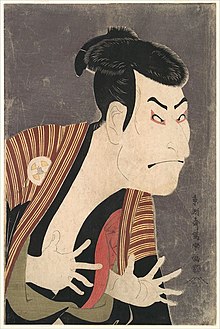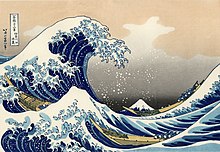Ukiyo-e
Ukiyo-e ( Japanese 浮世 絵 , roughly "images of the flowing world") is a collective term for a certain genre of Japanese painting and Japanese prints (illustrated books and woodblock prints ), which reflects the lifestyle and worldview of the emerging bourgeoisie and the broad majority of the population the major cities of Japan, particularly Edo ( Tokyo ), during the so-called Edo period .
In the literature, the term ukiyo-e is often incorrectly understood exclusively as the Japanese color woodcut , whereby the ukiyo-e paintings, which are little known in the West, are forgotten. In addition, all Japanese woodblock prints are usually subsumed under the term ukiyo-e, although, for example, depictions of animals and plants and many landscapes in the real sense are not included.
Definition of terms
The term ukiyo-e is made up of the words ukiyo and e, where e means picture. Ukiyo itself originally meant the "earthly, transitory world" and has a similar meaning in Buddhism as the term vanitas in the Christian view . It contains a rather pessimistic and life-renouncing mood. The change in meaning of ukiyo took place in Japan at the end of the 17th century. The everyday life of the emerging bourgeoisie (merchants, craftsmen and service providers of all kinds) in Edos and Osaka had changed. Instead of contemplation and the otherworldly, the reference to this world was taken and ukiyo now means something like "live and enjoy now".
"From now on it meant the world of pleasure and sensual pleasure, the world of theaters and the joyous quarters, the world of parties and extravagant luxury."
history
The term ukiyo-e is used for the first time in 1682 in the foreword of a book by Hishikawa Moronobu . "Pictures of the cheerful, flowing world" mean from now on the genre pictures, which have long since become common, in which the everyday life of people, their festivals and their surroundings were depicted. Painting had initially been an essential medium of dissemination, but in Kyoto and Osaka there were already books illustrated with simple black and white prints. With the further development of the associated techniques, the woodcut gained increasing importance as a means of disseminating ukiyo-e. Around 1700 the painters of the ukiyo-e still attach great importance to their differentiation from the draftsmen for woodcuts. A few decades later, the woodcut, which was initially monochrome and later hand-colored with just a few colors, had emancipated itself from painting as an independent form of expression.
With the development of multi-color printing around 1760 in Edo ( Tokyo ), from around 1790 in Osaka, a completely independent industry emerged that employed numerous craftsmen and, with their inexpensive products, gave broad sections of the population a certain, if only pictorial, participation in the amusements of life could offer. Several hundred publishers, as many artists, thousands of wood cutters and printers produced millions of prints in just a few decades up to the end of the Edo period in 1868. The performances of kabuki and bunraku , the big and small stars of the theater world and sumo arenas, the residents of the numerous brothels and other entertainment establishments, scenes from everyday life, the lives of the rich and beautiful and numerous varieties of sexual fantasies were presented.
After the opening of Japan by force of arms in 1854 and the end of the Edo period in 1868, the ukiyo-e hanga (prints of “images of the flowing world”) are nearing their end. Only a few artists continued their traditions unbroken until the end of the 19th century. Many Japanese artists are increasingly orienting themselves towards western influences and the Japanese public is also demanding more contemporary themes and forms of representation. The Japanese color woodcut never perished, however, the ukiyo-e hanga was increasingly replaced by sōsaku hanga and shin hanga in the course of the Meiji period . Both among the artists of the Meiji period and the representatives of the sosaku and shin hanga there are convincing masters of their subject.
In Japan, even a few decades ago, the ukiyo-e hanga were not considered art in the narrower sense, but were only viewed as handicrafts. In Europe, however, after they became known around 1870, they were the source of ideas for the great Impressionists and later to some extent also for the Expressionists, who were largely inspired by their room layout, lines and colors.
The passion of European and American art patrons for Japanese woodblock prints began around 1900 and since then they have been recognized as a completely independent art genre in the West.
Artist of the ukiyo-e hanga
- Hishikawa Moronobu (ca.1630–1694), Okumura Masanobu (1686–1764), Torii Kiyonobu (1664–1729), Ishikawa Toyonobu (1711–1785), Torii Kiyomitsu (1696–1716),
- Suzuki Harunobu (around 1725–1770), Isoda Koryusai (active 1765–180), Utagawa Toyoharu (1735–1814), Katsukawa Shunshō (active 1780–1800), Buncho (active 1765–1792),
- Kitagawa Utamaro (1753–1806), Torii Kiyonaga (1752–1815), Hosoda Eishi (1756–1829), Eishosai Choki (active 1785–1805), Tōshūsai Sharaku (active 1794–1795), Utagawa Toyokuni I (1769–1825 ),
- Katsushika Hokusai (1760–1849), Kikugawa Eizan (active 1804–1829), Keisai Eisen (1790–1848), Utagawa Kunisada (1786–1865), Utagawa Kuniyoshi (1798–1861), Utagawa (Andō) Utagawa Hiroshige (1797– 1858),
- Toyohara Kunichika (1835-1905), Toyohara Chikanobu (1838-1912), Tsukioka Yoshitoshi (1839-1892).
Probably the best-known Japanese woodcut in the West is probably Hokusai's painting “ The Great Wave off Kanagawa ” from the cycle “ 36 Views of Mount Fuji ”, which shows rowing boats on a stormy sea with Mount Fuji in the background. The picture fetched $ 68,500 in the Asiatica auction week in New York.
Individual evidence
- ↑ nzz-online of March 21, 2009
literature
- David Bell: Ukiyo-e explained. Global Oriental, Folkestone 2004, ISBN 1-901903-41-9 .
- Gordon Friese: Keisai Eisen. Utagawa Hiroshige. The 69 stations of the Kisokaidô. A complete series of Japanese woodblock prints and their print variants. Verlag im Bücherzentrum, Unna 2008, ISBN 978-3-9809261-3-3 .
- Gordon Friese: Hori-shi. 364 facsimiles of different seals by 107 Japanese woodcutters. = 364 facsimiles of different seals from 107 Japanese engravers. 2nd improved and increased edition. Verlag im Bücherzentrum, Unna 2009.
- Friedrich B. Schwan: Handbook Japanese Woodcut. Backgrounds, techniques, themes and motifs. Academium, Munich 2003, ISBN 3-89129-749-1 .
- Adele Schlombs: Hiroshige. 1797-1858. Master of Japanese Ukiyo-e Woodblock Print s. Cologne, Taschen 2010. ISBN 978-3-8365-2358-5
- Ludwig Bachhofer: The art of the Japanese woodcut masters . Munich, Kurt Wolff Verlag 1922.
Web links
- MAK Online Collection with over 4,100 works of Japanese prints
- https://ukiyo-e.org
- Collection of further links to Ukiyo-e
- National Library of Japan (Rare Books and Pictures Database, Japanese)
- Ukiyo-e caricatures 1842–1905 Database of Japanese Studies at the University of Vienna


